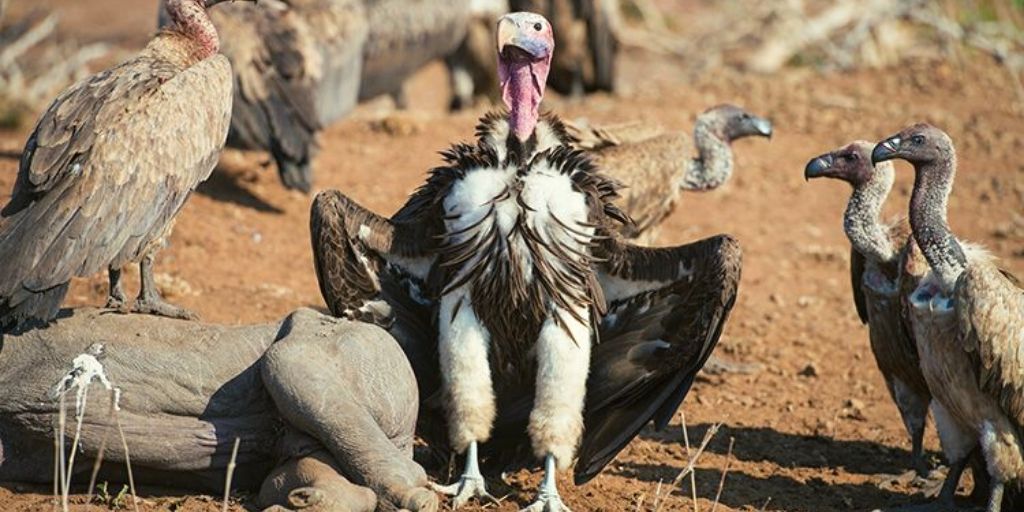The largest birds of prey in the world can be found on all continents outside of Australia and the Antarctic, living and hunting in a range of habitats from the sea and mountains to savanna and forests.
With their huge wingspans, hooked beaks, and sizable talons, the giant raptors below are all apex predators, masters of the skies. To supplement their impressive physical features all birds of prey have exceptional eyesight – the best in the natural world – with superb depth perception and rapid focus.
Two bird of prey definitions:
- A bird of prey is any bird that pursues other animals for food. Birds of prey fall into one of two orders: Falconiformes (including vultures, eagles, condors, falcons, and more) and Strigiformes (incuding owls).
- ‘Raptor‘ is another word for a bird of prey, and comes from the Latin word “rapere,” meaning “to seize.” Bird enthusiasts sometimes use the term raptor to refer to birds of prey that hunt during the daytime only, separating them from nocturnal birds of prey such as owls.
With this background in mind let’s look at our pick of 13 of the largest birds of prey in the world, listed in reverse wingspan size:
Harpy Eagle (Harpia harpyja)
Weight: 9 kgs
Wingspan: 2 meters

The beautiful harpy eagle
Though not the largest eagle in the world, a case can be made that harpy eagles are the most powerful eagles around. Their long talons have enough strength to break a human’s arm, and are put to good use hunting on sloths, monkeys, and other large birds.
Their wingspan is shorter than most other large birds of prey to allow them maneuverability in their habitats of dense forests in Central and South America. These stunning eagles are the national bird of Panama.
Philippine Eagle (aka Monkey Eagle) (Pithecophaga jefferyi)
Weight: 8 kgs
Wingspan: 2 meters

Philippine eagle in profile
The massive Philippine Eagle is a striking bird with blue-tinged black bill, pale gray-blue eyes, neon yellow feet, and creamy brown feathers.
This extremely rare predator is found on just four of the Philippines’ 7,000 islands, preferring to nest and hunt in the country’s ever-decreasing pristine primary forest. The Philippine eagles do eat monkeys but also preys on other medium and small-sized animals such as bats, civets, flying squirrels, other birds, snakes, and lizards.
African Crowned Eagle (Stephanoaetus coronatus)
Weight: 4.7 kgs
Wingspan: 2 meters

Head feathers of an African crowned eagle
The African crowned eagle is not the largest eagle in Africa, but is the most powerful eagle in Africa by some way due to the combination of their weight and thick legs with long talons.
They live in live Africa’s rainforests and woodland forests and are also seen on Africa’s savannas. Built for flying among trees, their wings are relatively short and broad, with a long rudder-like tail to help navigate through the branches.
The crowned eagle preys on animals up to four times their own weight, swooping down and breaking the prey’s spine with their talon. This diet includes African monkeys, guinea fowl, hyraxes, snakes, mongoose, and small antelopes.
Eurasian Eagle Owl (Bubo bubo)
Weight: 4.2 kgs
Wingspan: 2 meters

Eurasian eagle owl looks for prey
The Eurasian eagle owl is found across Europe and Asia in mountains and forests. It is a very large owl with prominent ear-tufts, and powerful feathered talons, which together make this one of the most powerful owls in the world.
Eurasian eagle owls are not fussy eaters, hunting many small mammals, reptiles, fish and birds – including other raptors.
Golden Eagle (Aquila chrysaetos)
Weight: 6.4 kgs
Wingspan: 2.3 meters

Golden eagle gliding
Golden eagles have a wide range across the northern hemisphere which covers North America, Europe, Asia, and small parts of North Africa. They are the largest bird of prey in North America and the national bird of Mexico.
These large predators are incredibly fast birds when diving, using their speed and talons to hunt primarily mid-sized mammals, though have been known to capture prey the size of coyotes and pronghorns.
Steller’s Sea Eagle (Haliaeetus pelagicus)
Weight: 9 kgs
Wingspan: 2.5 meters

Steller’s sea eagle catches a salmon
The Steller’s sea eagle is one of the heaviest eagles in the world, native to coastal areas of Eastern Eurasia and Japan. They are easily distinguished by their very large and powerful, yellow beak. They use this to hunt salmon, but supplement their diet with shellfish, crustaceans, and even baby seals if the opportunities arise.
Martial Eagle (Polemaetus bellicosus)
Weight: 6.2 kgs
Wingspan: 2.6 meters

Martial eagle on its nest
The Martial Eagle is one of the largest eagles in the world with its 2.6 meter wingspan. It’s such a powerful bird that it’s capable of knocking an adult man off his feet.
This magnificent bird is found across sub-Saharan Africa in open and semi-open areas from Senegal to Somalia and south to the Cape. It hunts mammals as large as small antelopes, monkeys, reptiles, and other large birds, though is not known to scavenge. Because martial eagles are known to attack livestock they are frequently hunted down by farmers.
Lappet-Faced Vulture (aka Nubian Vulture) (Torgos tracheliotos)
Weight: 10 kgs
Wingspan: 2.8 meters

A lappet-faced vulture next to a rhino carcass
The Lappet-faced Vulture has the largest wing-span of all the birds of Africa, and also goes by the names Nubian vulture and African eared vulture. The species is easily recognizable due to its large size, bare pink head, and the lappets on each side of its neck – the fleshy folds of skin.
Built for scavenging, their powerful beak is able to tear the hides, tendons, and any other tissue from its prey, which may be too tough for other scavengers. As the largest vulture in Africa, the Lappet-faced vulture dominates other vultures during feeding, and is strong enough to drive off a jackal.
Bearded Vulture (aka Lammergeier or Lammergeyer) (Gypaetus barbatus)
Weight: 8 kgs
Wingspan: 3 meters

The distinct-looking bearded vulture
The bearded vulture also goes by the name ‘lammergeyer’, and is one of the largest birds of prey in the world by both weight and wingspan. Found in pockets of southern Europe they live in mountainous areas only, usually above the tree line.
Bearded vultures are easy to spot with their black ‘sideburns’ and red rings around their eyes. Unlike many of the raptors on this list, the lammergeyer tends not to hunt live prey, preferring to scavenge on animal carcasses. Thye have a unique eating style whereby they carry a carcass high into the air and drop it onto rocks to shatter large bones before eating them.
California Condor (Gymnogyps californianus)
Weight: 12 kgs
Wingspan: 3 meters

Pair of Californian condors
The bald-headed California Condor is only slightly small than the Andean Condor and ties the American white pelican for the largest wingspan of any bird in the United States. These condors don’t build nests but seek out ready nesting spots in cliff caves, rock crevices, or redwood hollows.
Their diet mainly consists of carrion along the lines of deer, cattle, sheep, and rabbits, and are tough birds, living around 50 years in the wild and able to go for a couple of weeks without eating.
Eurasian Black Vulture (aka Cinereous Vulture) (Aegypius monachus)
Weight: 9.5 kgs
Wingspan: 3.1 meters

Cinereous vulture eyeing up a meal
The cinereous vulture (Aegypius monachus) is the heaviest and largest bird of prey in the world, found in isolated pockets across Eurasia from Spain to Korea.
This Old World vulture has excellent eyesight, allowing it to spot carrion whilst in flight. Their looks are somewhere between an eagle and vulture, with the stern gaze and classic vultures’ featherless head to prevent a build-up of blood when it feeds, surrounded by a fluffy collar of feathers.
Himalayan Griffon Vulture (Gyps himalayensis)
Weight: 12.5 kgs
Wingspan: 3.1 meters

A mean-looking Himalayan griffon vulture
Named after the mythical giffon with its lion’s body and eagle’s head and wings of an eagle, the Himalayan Griffon Vulture is technically a man-eater, playing its part in Tibetan sky burials by scavenging human remains left out on Celestial burial ground.
The huge raptors commonly live in loose colonies and travel and nest close to one another.
Andean Condor (Vultur gryphus)
Weight: 15 kgs
Wingspan: 3.3 meters

Andean condor on a rock
Found in the Andes mountain range the Andean condor has the largest wingspan of any raptor, only beaten to the world’s longest wingspan by a couple of sea birds, and is one of the world’s largest flying birds.
The winds and thermals in their mountain environment help them to keep their hefty weight aloft in the air, and they prefer to stick to flightpaths where they know they can flight paths that make use of mountain air currents.
Andean condor are primarily scavengers that feed on large carrion, but are known to supplement carrion with eggs or hatchlings from other bird species.
And that’s your lot for our take on the largest birds of prey in the world. Have you had the opportunity to see any of these stunning huge raptors in real life? Please share your experiences in the comments section below!



Discover more of our bird posts…
The Largest Eagles In The World
November 16, 2020/by EdThe Biggest Birds In The World
October 14, 2020/by EdThe World’s Largest Flying Birds
November 19, 2020/by EdBirds of Africa
July 1, 2020/by EdBirds That Mate For Life
September 30, 2020/by EdWhy Are Flamingos Pink?
August 26, 2020/by EdThe Smallest Birds In The World
October 4, 2020/by Ed17 Iconic Flightless Birds
November 18, 2020/by EdThe Fastest Birds In The World – Air, Land & Sea
January 10, 2021/by Ed